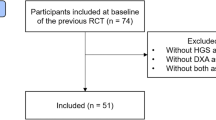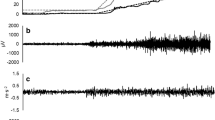Abstract
Strength and muscle mass are important determinants of health status, and reference values for pediatric populations from every country or geographic region are needed. The aim of this study was to develop age- and sex-specific reference values of muscle strength and evaluate the correlation between muscle strength and appendicular lean mass in Mexican children and adolescents. A cross-sectional study was conducted in 1111 healthy subjects ages 5 to 19 years of age participating in the “Body Composition Reference Values in Mexican Children and Adolescents” study. Smoothed reference values for the 1, 3, 5, 15, 25, 50, 75, 85, 95, 97, and 99 percentiles of muscle strength for upper and lower limbs were developed based on age and sex using Jamar® and Microfet2® dynamometers. Mean values were derived using the Generalized Additive Models for Location, Scale and Shape (GAMLSS), and lean mass was determined using dual-energy X-ray absorptiometry. Highly positive correlations of muscle strength with lean mass in upper limbs were found r-values 0.87–0.92 for boys and r = 0.80–0.86 for girls. High and moderate positive correlations for lower limbs were also noted for upper limbs: r = 0.74–0.86 for boys and r = 0.67–0.82 for girls. The reference values for appendicular muscle strength established in this study demonstrated a high and positive correlation between appendicular mass and muscle strength. These data will be useful when evaluating conditions and diseases affecting muscle or sports.


Similar content being viewed by others
References
Lopez-Gonzalez D, Wells JC, Cortina-Borja M et al (2021) Reference values for bone mineral density in healthy Mexican children and adolescents. Bone. https://doi.org/10.1016/j.bone.2020.115734
Benfica PDA, Aguiar LT, Brito SAF et al (2018) Reference values for muscle strength: a systematic review with a descriptive meta-analysis. Brazilian J Phys Ther 22:355–369. https://doi.org/10.1016/j.bjpt.2018.02.006
Sayer AA, Syddall H, Martin H et al (2009) The developmental origins of sarcopenia. Nutr Heal Aging 12:427–432
Álvarez-Velázquez, Iván Misael; Álvarez-Velázquez, Félix Fernando; Álvarez-Barreras, Fernando; Mena-Ramos R (2006) El proceso de asimilación de la fuerza en el músculo del ser humano. Ra Ximhai Rev Soc Cult y Desarro Sustentable 2:533–548
World Health Organization (2000) The implications for training of embracing: a life course approach to Health. A Life course approach to heal world heal organ 1–336
Lundgren SS, Nilsson JÅ, Ringsberg KA, Karlsson MK (2011) Normative data for tests of neuromuscular performance and DXA-derived lean body mass and fat mass in pre-pubertal children. Acta Paediatr 100:1359–1367. https://doi.org/10.1111/j.1651-2227.2011.02322.x
de Souza MA, de Jesus Alves de Baptista CR, Baranauskas Benedicto MM et al (2014) Normative data for hand grip strength in healthy children measured with a bulb dynamometer: a cross-sectional study. Physiother (United Kingdom) 100:313–318. https://doi.org/10.1016/j.physio.2013.11.004
Bobos P, Nazari G, Lu Z, MacDermid JC (2020) Measurement properties of the hand grip strength assessment: a systematic review with meta-analysis. Arch Phys Med Rehabil 101:553–565. https://doi.org/10.1016/j.apmr.2019.10.183
Ploegmakers JJW, Hepping AM, Geertzen JHB et al (2013) Grip strength is strongly associated with height, weight and gender in childhood: a cross sectional study of 2241 children and adolescents providing reference values. J Physiother 59:255–261. https://doi.org/10.1016/S1836-9553(13)70202-9
Gutierrez GM, Conte C, Lightbourne K (2014) The relationship between impact force, neck strength, and neurocognitive performance in soccer heading in adolescent females. Pediatr Exerc Sci 26:33–40. https://doi.org/10.1123/pes.2013-0102
Dodds RM, Syddall HE, Cooper R et al (2014) Grip strength across the life course: Normative data from twelve British studies. PLoS ONE 9:1–15. https://doi.org/10.1371/journal.pone.0113637
Stephenson ML, Smith DT, Heinbaugh EM et al (2015) Total and lower extremity lean mass percentage positively correlates with jump performance. J Strength Cond Res 29(8):2167–2175. https://doi.org/10.1519/JSC.0000000000000851
Wang Y-C, Bohannon RW, Li X et al (2018) Hand grip strength: normative reference values and equations for 18- to 85-year-olds residing in the United States. J Orthop Sport Phys Ther 4(8):1–34
Jürimäe T, Hurbo T, Jürimäe J (2009) Relationship of handgrip strength with anthropometric and body composition variables in prepubertal children. HOMO J Comp Hum Biol 60:225–238. https://doi.org/10.1016/j.jchb.2008.05.004
Almuzaini KS (2007) Muscle function in Saudi children and adolescents: relationship to anthropometric characteristics during growth. Pediatr Exerc Sci 19:319–333. https://doi.org/10.1123/pes.19.3.319
Saied Alkholy WA, El-Wahab MSE-D, Elshennawy S (2017) Hand grip strength in relation to anthropometric measures of school children: a cross sectional study. Ann Med Health Sci Res 7:447–453
Hogrel JY (2015) Grip strength measured by high precision dynamometry in healthy subjects from 5 to 80 years. BMC Musculoskelet Disord. https://doi.org/10.1186/s12891-015-0612-4
Hazell TJ, Sharma AK, Vanstone CA et al (2014) Normative data and predictors of leg muscle function and postural control in children. Med Sci Sports Exerc 46:2184–2190. https://doi.org/10.1249/MSS.0000000000000340
Marrodán Serrano MD, Romero Collazos JF, Moreno Romero S et al (2009) Handgrip strength in children and teenagers aged from 6 to 18 years: Reference values and relationship with size and body composition. An Pediatr 70:340–348. https://doi.org/10.1016/j.anpedi.2008.11.025
de Onis M, Onyango A, Borghi E et al (2007) Development of a WHO growth reference for school-aged children and adolescents. Bull World Heal Organ 85:812–819. https://doi.org/10.2471/BLT
Marshall WA, Tanner JM (1970) Variations in the pattern of pubertal changes in boys. Arch Dis Child 45:13–23
Marshall WA, Tanner JM (1970) Variations in pattern of pubertal changes in girls. Obstet Gynecol Surv 25:694–696. https://doi.org/10.1097/00006254-197007000-00018
Stasinopoulos DM, Rigby RA (2007) Generalized additive models for location scale and shape (GAMLSS). J Stat Softw 23:1–46. https://doi.org/10.1837/jss.v023.i07
Rojas CJA, del Vázquez Uc L, C, Sánchez Valentìn G, et al (2012) Dinamometria de manos en estudiantes de Merida, México. Rev Chil Nutr 39:45–51. https://doi.org/10.4067/S0717-75182012000300007
Carreira H, Amaral TF, Brás-Silva C et al (2010) Força da preensão da mão numa amostra de crianças dos 11 aos 14 anos. Acta Med Port 23:811–818
Tounsi M, Aouichaoui C, Elloumi M et al (2015) Reference values of vertical jumping performances in healthy Tunisian adolescent. Ann Hum Biol 42:117–125. https://doi.org/10.3109/03014460.2014.926989
Henneberg M, Brush G, Harrison GA (2001) Growth of specific muscle strength between 6 and 18 years in contrasting socioeconomic conditions. Am J Phys Anthropol 115:62–70. https://doi.org/10.1002/ajpa.1057
Hogrel J-Y, Decostre V, Alberti C et al (2012) Stature is an essential predictor of muscle strength in children. BMC Musculoskelet Disord 13:176. https://doi.org/10.1186/1471-2474-13-176
Temfemo A, Hugues J, Chardon K et al (2009) Relationship between vertical jumping performance and anthropometric characteristics during growth in boys and girls. Eur J Pediatr 168:457–464. https://doi.org/10.1007/s00431-008-0771-5
Bruyère O, Beaudart C, Reginster JY et al (2016) Assessment of muscle mass, muscle strength and physical performance in clinical practice: An international survey. Eur Geriatr Med 7:243–246. https://doi.org/10.1016/j.eurger.2015.12.009
de Lima TR, Moraes MS, Martins PC et al (2018) Diversity of parameters in the muscle strength evaluation of Brazilian school children and adolescents: a systematic review. Rev Bras Cineantropometria e Desempenho Hum 20:497–516. https://doi.org/10.5007/1980-0037.2018v20n4p497
Isen J, McGue M, Iacono W (2014) Genetic influences on the development of grip strength in adolescence. Am J Phys Anthropol 154:189–200. https://doi.org/10.1002/ajpa.22492
Kenjle K, Limaye S, Ghugre PS, Udipi SA (2005) Grip strength as an index for assessment of nutritional status of children aged 6–10 years. J Nutr Sci Vitaminol (Tokyo) 51:87–92. https://doi.org/10.3177/jnsv.51.87
Alberga AS, Farnesi BC, Lafleche A et al (2013) The effects of resistance exercise training on body composition and strength in obese prepubertal children. Phys Sportsmed 41:103–109. https://doi.org/10.3810/psm.2013.09.2028
Godoy-Cumillaf A, Bruneau-Chávez J, Fuentes-Merino P et al (2020) Reference values for fitness level and gross motor skills of 4–6-year-old chilean children. Int J Environ Res Public Health 17:1–17. https://doi.org/10.3390/ijerph17030797
Rogol AD (2003) Growth, body composition and hormonal axes in children and adolescents. J Endocrinol Invest 26:855–860. https://doi.org/10.1007/BF03345236
Carrasco Páez L, Torres Luque G (2015) El entrenamiento de fuerza en niños. Apunt Educ física y Deport 3(61):64–73. https://raco.cat/index.php/ApuntsEFD/article/view/306891
Miyatake N, Miyachi M, Tabata I et al (2012) Relationship between muscle strength and anthropometric, body composition parameters in Japanese adolescents. Health (Irvine Calif) 04:1–5. https://doi.org/10.4236/health.2012.41001
Schoenau E (2005) From mechanostat theory to development of the “Funtional Muscle-Bone-Unit.” J Musculoskelet Neuronal Interact 5:232–238
Dekkers KJFM, Rameckers EAA, Smeets RJEM, Janssen-Potten YJM (2014) Upper extremity strength measurement for children with cerebral palsy: a systematic review of available instruments. Phys Ther 94:609–622. https://doi.org/10.2522/ptj.20130166
Acknowledgements
We want to thank to all participating children and their parents. Also to the Consejo Nacional de Ciencia y Tecnología in México City. To Universidad Nacional Autónoma de México, program of Master´s and Doctorate in Health Sciences.
Author information
Authors and Affiliations
Contributions
ALAS: designed and carried out the study and prepared the first draft of the paper. EDG, DLG, MM, PC: conducted the research. ALAS and DLG was responsible for statistical analysis of the data; ALAS, EDG, PC: wrote the manuscript; PC: designed the study and critically reviewed and wrote the manuscript. All authors reviewed and commented the paper for intellectual content and approved the final version. All authors agree to be accountable for the work and to ensure that any questions relating to the accuracy and integrity of the paper are investigated and properly resolved.
Corresponding author
Ethics declarations
Conflict of interest
The authors have no financial or proprietary interests in any material discussed in this article.
Human and Animal Rights and Informed Consent
This study was managed according to the Declaration of Helsinki guidelines. The Bioethics committee at the Children’s Hospital of Mexico Federico Gómez (No. HIM 2016-110. SSA) reviewed and approved the study protocol and informed consent forms.
Additional information
Publisher's Note
Springer Nature remains neutral with regard to jurisdictional claims in published maps and institutional affiliations.
Supplementary Information
Below is the link to the electronic supplementary material.
Rights and permissions
Springer Nature or its licensor holds exclusive rights to this article under a publishing agreement with the author(s) or other rightsholder(s); author self-archiving of the accepted manuscript version of this article is solely governed by the terms of such publishing agreement and applicable law.
About this article
Cite this article
Almiray-Soto, A.L., Denova-Gutiérrez, E., Lopez-Gonzalez, D. et al. Muscle Strength Reference Values and Correlation with Appendicular Muscle Mass in Mexican Children and Adolescents. Calcif Tissue Int 111, 597–610 (2022). https://doi.org/10.1007/s00223-022-01025-4
Received:
Accepted:
Published:
Issue Date:
DOI: https://doi.org/10.1007/s00223-022-01025-4




